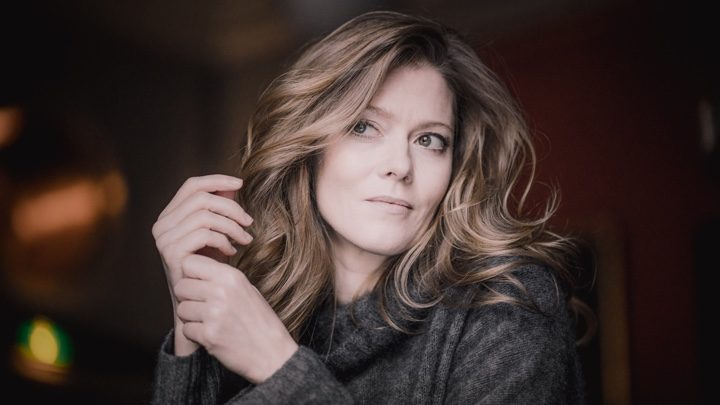

In the Park Avenue Armory’s Board of Officers Room, a fine, tall cube for a recital series, she gave two concerts this week. I missed the first one, devoted to John Zorn. At the second, on Thursday, Hannigan chose to sing works that tested her metal in odd corners of vocalism.
Luigi Nono’s “Djamila Boupacha” is a doom-laden lullaby, ranging over the scale in a despairing half-dream: the torments of the text mediated a little by the clean vocal technique.
John Cage’s setting of e.e. cummings, “Experiences No. 2,” illustrates a sonnet of languid, erotic reveries, like phrases that pop into the mind as one drowsily ravels amorous bedclothes, with languid humming lines between gorgeous figures of speech:
“It is at moments after I have dreamed
of the rare entertainment of your eyes …
the genuine apparition of your smile ….”
Luciano Berio’s “Sequenza 3” called on non-singing performance, obbligato hoots and squeaks and snaps and clucks and mutters and snorts and coughs and clenched fists or open hands to muffle text, all of it rendered in prim, precise, swift-moving rhythms.
All these works were sung a cappella. Perhaps to vary the assault on our ears and give the singer space to breathe between workouts, each was paired with a solo work for a stringed instrument. Violinist Eugene Drucker played Augusta Read Thomas’s “Incantation”; cellist Paul Watkins performed a prelude by Huw Watkins; and Philip Setzer, John Harbison’s “Serenade for Solo Violin.”
These alternatives seemed to echo rather than intrude upon the vocal works they were paired with, responding to the emotional journey with a corresponding return. The solo lines sang, as Hannigan’s solos twined and harmonized.
In the second half of the concert, Hannigan having changed from the artistic look, loose white blouse, loose tossed hair and black slacks of the first half to severe purple velvet that emphasized her height and slimness and columnar throat, rising to a proud, self-aware face like the head of a caryatid on some Jugendstil façade, she performed the two Lieder by Stefan George that are the third and fourth movements of Schönberg’s Quartet No. 2.
The piece was performed by the Emerson Quartet, the three soloists who had already appeared in the first half plus violist Lawrence Dutton, who has rather more of the leading role in this work than the average violist gets in a quartet, and provided it with outgoing brilliance.
Hannigan’s voice descended to a quiet, almost cavernous numbness for the despairing prayers of “Litanei” (some of the lowest notes revealed the only indication of less than ideal command in her technique all night) and lifted us in gradual exultation for the measured, not too confident triumphs of “Entrückung.”
She coupled gorgeously with the quartet, using the texture of the music as a platform for the poetry’s message, distinctly a member of a balanced ensemble rather than glorying in her own wonderful timbre.
Hannigan is a conductor as well as a soloist, but on this thrilling occasion she was a colleague and partner.
Photo credit: Marco Borggreve
Merry Widow | Finger Lakes, NY | July 25-28
Geneva Light Opera’s production of Lehar’s The Merry Widow will feature prize-winning baritone Bryan Murray and soprano Alexis Olinyk in the superb acoustics of in the landmark Smith Opera House in Geneva, New York on July 25, 27, and 28. A small city on the north end of the largest of NY’s Finger Lakes, Geneva…
Geneva Light Opera’s production of Lehar’s The Merry Widow will feature prize-winning baritone Bryan Murray and soprano Alexis Olinyk in the superb acoustics of in the landmark Smith Opera House in Geneva, New York on July 25, 27, and 28. A small city on the north end of the largest of NY’s Finger Lakes, Geneva…
-
Topics: barbara hannigan, park avenue armory, recital, review
Latest on Parterre
Reach your audience through parterre box!
parterre box, “the most essential blog in opera” (New York Times), is now booking display and sponsored content advertising for the 2023-2024 season. Join Carnegie Hall, Lincoln Center, Warner Classics and many others in reaching your target audience through parterre box.
parterre box, “the most essential blog in opera” (New York Times), is now booking display and sponsored content advertising for the 2023-2024 season. Join Carnegie Hall, Lincoln Center, Warner Classics and many others in reaching your target audience through parterre box.
parterre in your box?
Get our free weekly newsletter delivered to your email.

























Comments